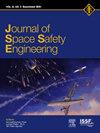火星样本返回地球入口飞行器着陆过程中碎片撞击二级安全壳的氢代码模拟
IF 1.7
Q3 ENGINEERING, AEROSPACE
引用次数: 0
摘要
美国宇航局的样品返回任务必须满足落后的行星保护要求,其中包括需要确保坚固的密封。2023年12月到位的地球进入系统架构在从运载飞船释放后是被动的;进入轨道是弹道,没有使用降落伞。在释放时,该系统的目标是降落在犹他测试和训练靶场内的软土上,土壤的位移应该会吸收大部分的冲击能量。在不太可能发生的情况下,车辆撞击到坚硬的表面,或者损坏的车辆以高于预期的速度着陆,隔热罩可能会破裂,并可能导致碎片撞击容纳样本的次级安全壳。本文描述了一组潜在碎片撞击二级安全壳的氢代码模拟,以表明2023设计可以承受这种冲击,并且除了冲击速度超过200米/秒外,安全壳损失的风险可以忽略不计。本文章由计算机程序翻译,如有差异,请以英文原文为准。
Hydrocode simulations of debris impacts on the secondary containment vessel during landing of the Mars Sample Return earth entry vehicle
NASA sample return missions must satisfy backward planetary protection requirements which include the need to assure robust containment. The Earth Entry System architecture that was in place in December 2023 is passive after release from the carrier spacecraft; the entry trajectory is ballistic, and no parachute is used. At release, the system is targeted to land on soft soil within the Utah Test and Training Range, and displacement of the soil should absorb much of the impact energy. In the unlikely event that the vehicle impacts a hard surface, or a damaged vehicle lands at higher-than-predicted velocity, the heat shield may break and potentially cause debris to impact the Secondary Containment Vessel which houses the samples. This paper describes a set of hydrocode simulations of potential debris items striking the Secondary Containment Vessel, to show that the 2023 design can withstand such impacts and the risk of loss of containment is negligible except at impact velocities in excess of 200 m/s.
求助全文
通过发布文献求助,成功后即可免费获取论文全文。
去求助
来源期刊

Journal of Space Safety Engineering
Engineering-Safety, Risk, Reliability and Quality
CiteScore
2.50
自引率
0.00%
发文量
80
 求助内容:
求助内容: 应助结果提醒方式:
应助结果提醒方式:


